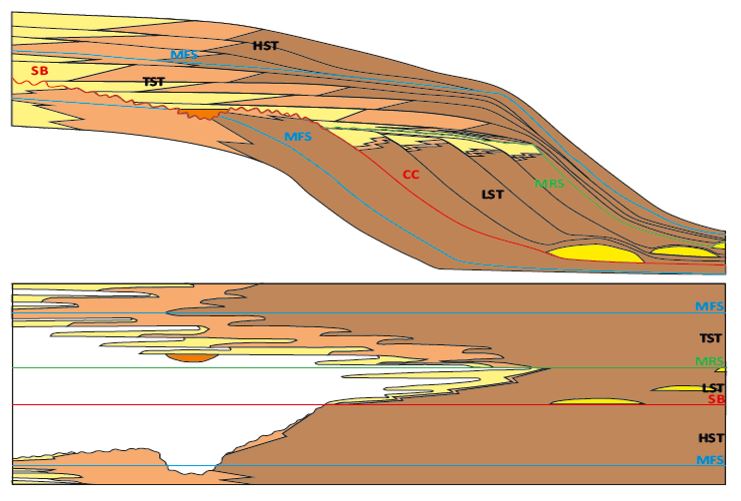Table of Contents
Characterising Sequence Components Using Fossils
We need to establish characteristic “paleontological signatures” or “fingerprints” for surfaces and components of a sequence. In order to do that we need to know how the fossils – as living organisms – respond to changes in sea level and, to an extent, sediment supply.
Sequence surfaces provide the broad horizons that separate individual sequences and sequence components (“systems tracts”) and also the mechanism by which sequences are biostratigraphically calibrated and therefore correlated on a well-to-well and eventually regional basis.
Readers should be familiar with the biostratigraphical principles and applications to (a) Biostratigraphy and Correlation and (b) Paleoenvironments (see Table of Contents on home page). Sequence biostratigraphy brings these two aspects together in a fully integrated way.

Schematic diagram of a typical third-order depositional sequence and its main components. The upper image is scaled against rock thickness, the lower image is scaled to time.
The three main surfaces which occur within an individual sequence are:
- the sequence boundary (SB) or (distally) correlative conformity (CC)
- the maximum regressive surface (MRS) (sometimes called the “transgressive surface (TS)”)
- the maximum flooding surface (MFS).
The SB is a negative surface in that, its proximal expression is as an unconformity, it represents a period of missing time expressed as erosion or at least non-deposition (red wavy line above). In distal settings deposition may be continuous (though at a very low rate) and therefore an unconformity (in the strict sense) may not be present. This surface is termed a Correlative Conformity (CC) (red non-wavy line).
The same may also be said in some respects of the MRS (green non-wavy line).
The MFS is a positive surface expressed within an actual rock unit representing (more-or-less) continuous deposition during the maximum landward extent of marine conditions, although at a far greater extent that the CC, usually extending from very proximal areas and well into the basin (blue non-wavy line).
The importance of the surfaces is that, because they are eustatically controlled, they are laterally extensive. Furthermore if they can be biostratigraphically calibrated with consistent marker species, they can be correlated at basin, region and even global scales.
The rock units between the surfaces are called Systems Tracts. They effectively build the rock record. The principle systems tracts are:
- the lowstand systems tract (LST) comprising the lowstand wedge (LSW) and fan (LSF)
- the transgressive systems tract (TST)
- the highstand systems tract (HST) including the shelf-margin wedge (SMW)
(The LSF and SMW are often not developed)
A sequence is formed during a cycle of a sea-level fall and subsequent rise (described on other pages). We can make an educated assumption as to how fossils - both those that dwell on or in the sea floor sediment and those that float or swim above it - might respond to these changes. These responses should be visible in the fossil record within a sequence.
Often, a sea-level fall will expose the continental shelf and cause erosion and sediment re-deposition (the SB). Marine organisms that inhabited the continental shelf would die out. Erosion/Re-deposition causes fossils that previously inhabited shallower (shelf) environments to be transported downslope into deeper-water (bathyal) sediments. During this period (the LST) water-depths progressively decrease as the basin fills up with sediment (the sea-level itself is not changing much), raising the level of the sea-floor. This “shallowing-upwards” trend can be visible in the changing composition of the fossil assemblages.
When sea-levels rise (during a transgression - TST) the exposed shelf is gradually submerged and bottom-living organisms can re-colonise the newly created environmental niches. Planktonic organisms can also be re-introduced as sea-levels rise. During this phase, sea-level rise is often rapid and water-depths get progressively deeper, resulting in a “deepening-upwards” trend in the fossil assemblages.
When sea-levels reached their maximum landward extent (the MFS) planktonic organisms thrive and leave their fossil traces across the entire basin and are often the dominant microfossil types.
During the high-stand phase (HST) sea-levels are high but do not change much. The continuing build-up of sediments raises the level of the sea-floor and water-depths shallow progressively resulting in another “shallowing-upwards” trend in the fossil assemblages.
It is important to note that, at a single location - such as the vertical penetration by a borehole of a subsurface sequence - not all sequence components will be encountered. For example, when encountering the distal part of a sequence it is unlikely that any HST sediments will be observed.